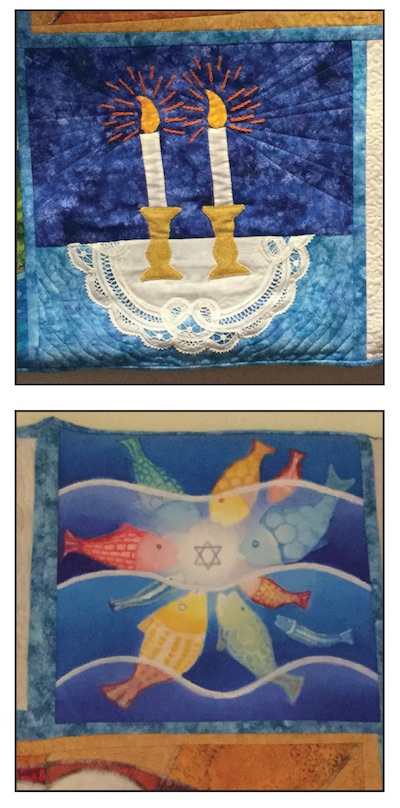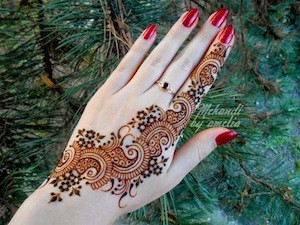Congregation Emanu-El’s chuppah is on display throughout the summer. (photo by Janna Ginsberg Bleviss)
Congregation Emanu-El in Victoria is celebrating its 155th year. It is marking the occasion, in part, with the art exhibit Encounters, as well as by displaying a quilted chuppah that was created by a group of women in the community for the congregation’s 150th birthday.
The creation of the quilt was spearheaded by Janna Ginsberg Bleviss, who talked with the Independent about this unusual project.
“Five years ago, when Congregation Emanu-El was celebrating its 150th anniversary, I was active with a couple of projects,” she said, “and I was looking for a specific art project. Rabbi Harry Brechner suggested a new chuppah.”
The original chuppah of Emanu-El has a long history. According to Ginsberg Bleviss, it dated from 1864. Made in England from Chinese silk with gold embroidery, it was donated to the synagogue by the Hebrew Ladies of Victoria. Throughout the intervening century and a half, it had been used repeatedly. Of course, by 2013, it was showing its age. “It was frayed and tired looking,” said Ginsberg Bleviss.
The congregation needed a new chuppah, but was unsure how to approach the making of a new one. “Rabbi Harry directed me to Colleen Golumbia, a gifted quilter and fabric artist,” recalled Ginsberg Bleviss. “I had seen her work at the shul’s Calling All Artists displays and I thought that a fabric project would be suitable for the chuppah, as I already knew many textile artists. Colleen agreed to work with me, to coordinate putting the pieces together and make it look like a chuppah. She was absolutely the right person to be involved.”
Golumbia decided the chuppah would feature a central panel surrounded by 12 squares. “Colleen designed the gorgeous centre piece, resembling the stained glass window in the sanctuary ceiling, with colours of gold, red, white and blue,” said Ginsberg Bleviss.
Meanwhile, Ginsberg Bleviss put out a call and found 12 women interested in creating the surrounding panels. In the end, 14 women worked on the project.
“These women ranged in ages, the oldest [then] being 86. They came from Victoria, [elsewhere on] Vancouver Island and even as far away as Washington, D.C. Some were professional artists, some were experienced sewers or quilters or knitters, some worked in fabric from time to time and some took it on as a challenge. They were all pleased to participate in this project. Although not all were synagogue members, all were connected in some way to Congregation Emanu-El.”
Golumbia gave snatches of fabric to everyone in the colours of her portrayal of the stained glass window, thus linking the whole composition by colour; other than that, every participating woman had full creative freedom. Ginsberg Bleviss recalled: “I was frustrated at first because I kept asking Colleen: ‘Don’t you want to give them some directions?’ She didn’t.”
The artists got together a few times anyway, to share and learn from one another. Since they didn’t all live in Victoria, they mostly communicated through emails circulated by Ginsberg Bleviss.

“When the squares came in, the diversity and similarities were quite amazing. Many used the Magen David in various forms. There were images of Judaism, nature, light and colour. Some of the squares were abstract. Only one had words on it – the last piece that came in was from Washington, D.C. It said, ‘I am my beloved and my beloved is mine,’ which is often said at weddings. Done by Nancy Micklewright, it was a stunning gold stencil on a white background…. Phyllis Serota, known for her early fish paintings, painted fish coming into a Magen David centre. Annette Wigod, our oldest contributor, sewed Shabbat candles and used an antique doily as the tablecloth. Enid Elliot created a West Coast theme of oceans, mountains and sky. Arlene Ackerman, another experienced quilter, created pomegranates.”
The other participants included Narcis Kellow, Isa Milman, Jackie Saunders Ritchie, Natalie Beher, Charlotte Sutker, Gail Steinberg, Janis Diner Brinley and Barbara Horowitz.
“It was truly a communal effort, vibrant and colourful, meticulously sewn together,” Ginsberg Bleviss said. “Some squares were hand-stitched, some machine-stitched, some reflected quilting traditions, and some used appliqué. It was extremely varied. Colleen put all the pieces together and did the quilting lines. Several months later, in March 2013, we handed it to the synagogue as a donation from all the women…. It was too beautiful not to let others see it. We decided to place it in the sanctuary, where it has been ever since. Its first proper use came that same summer for the wedding of one of the artists and her partner.”
The old chuppah now resides at Royal B.C. Museum, although it was brought out for the 150th historical exhibit at Emanu-El.
Five years have passed since the new chuppah’s creation, and Ginsberg Bleviss thought it was time to display it to a wider audience.
“It was hanging in the sanctuary, with no explanation,” she said. “It kind of looked like a wall-hanging. I wanted to acknowledge the shul’s 155th anniversary this year and felt that there was still something to be learned about the chuppah and the process that went on in 2013. I wanted to move the chuppah to a more visible spot and give it some attention.”
Besides, everyone was getting older, she added. The oldest participant, Annette Wigod, is now 91. Ginsberg Bleviss wanted to give each woman a chance to talk about their pieces and what inspired them.
The new exhibit consists of the chuppah, the creators’ photographs and a story of each square.
“It is modern and beautiful, something that we could all be proud of,” said Ginsberg Bleviss. “I hope it might last as long as the original chuppah.”
Olga Livshin is a Vancouver freelance writer. She can be reached at [email protected].



